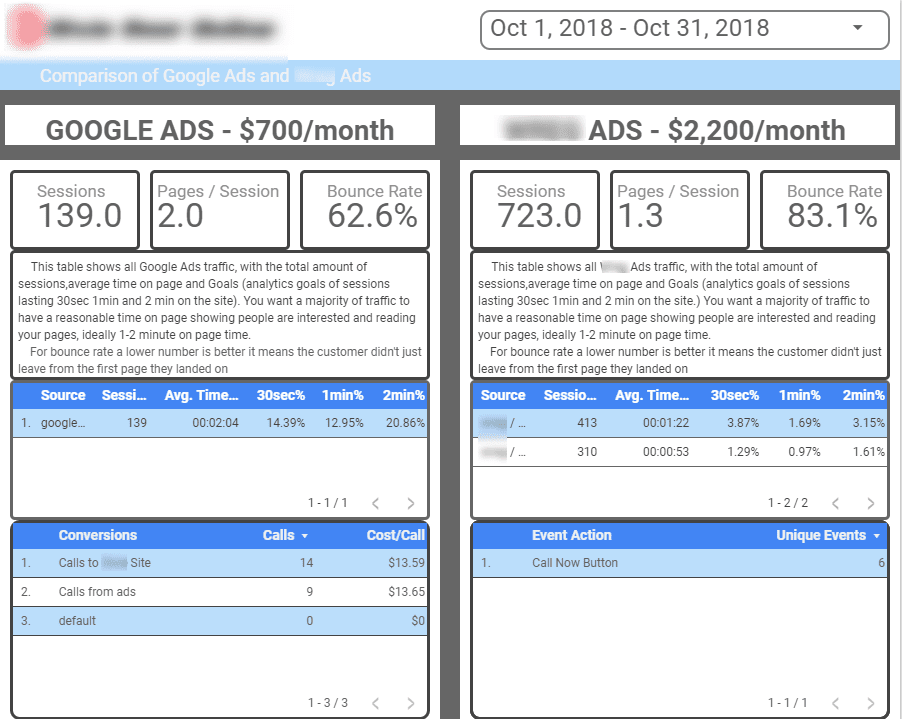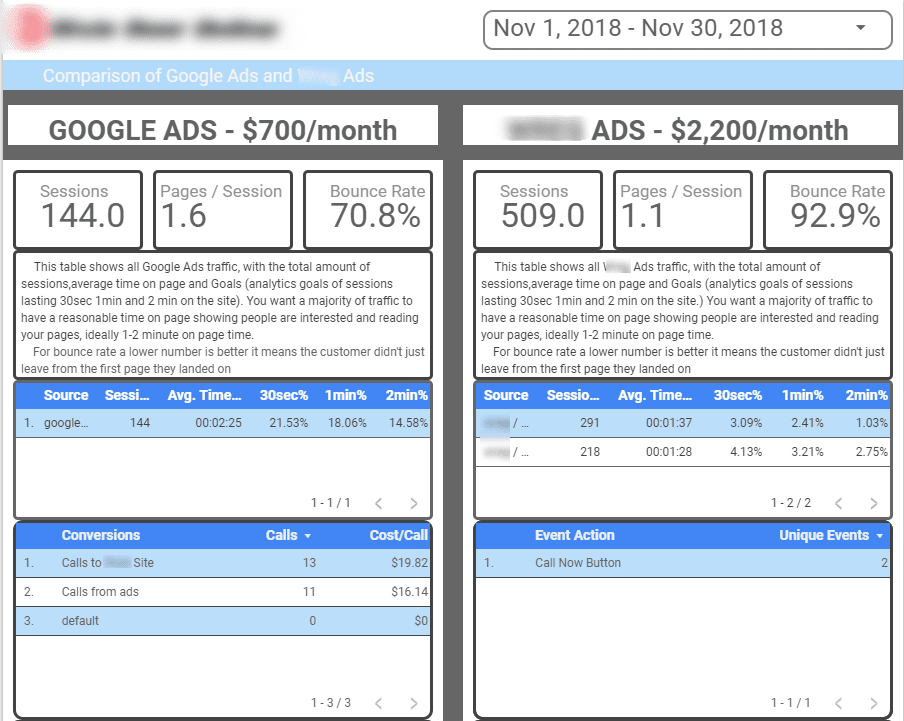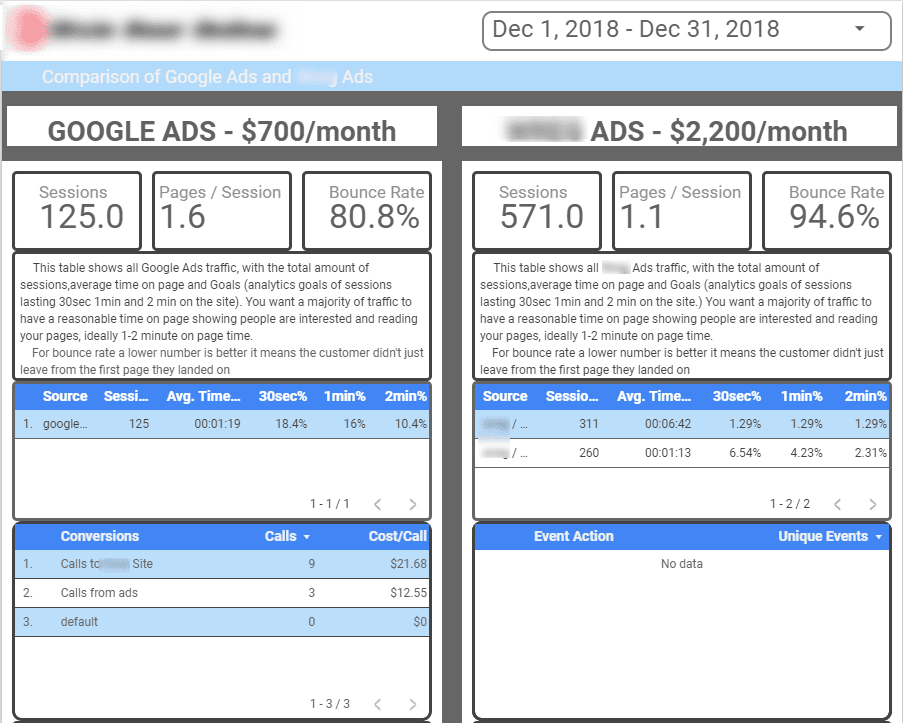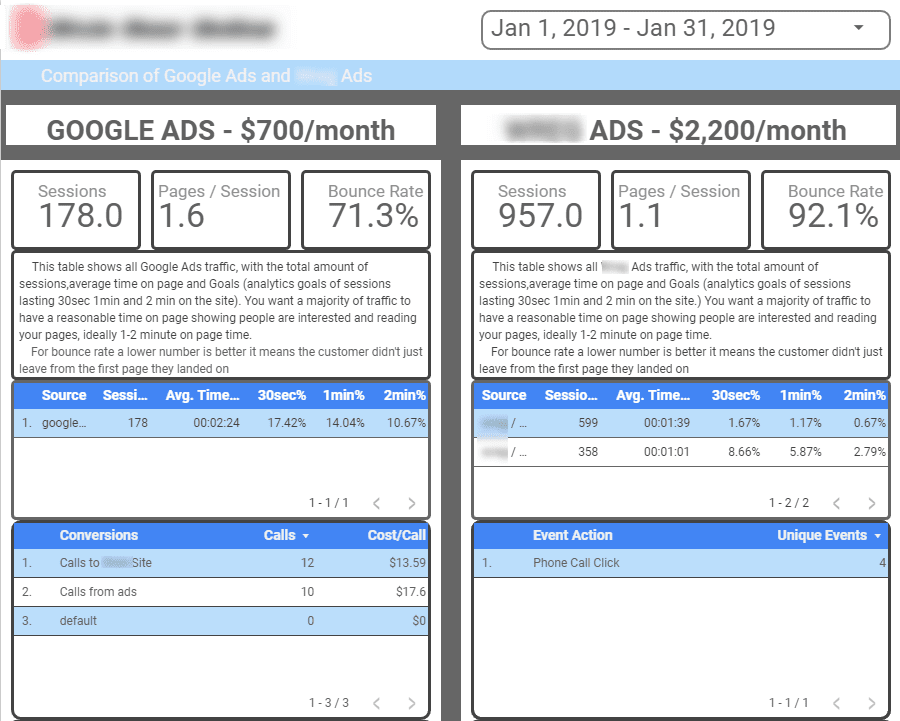
There’s been a lot of questions about which platform is better to run advertising on for your business. Here are my insights into what the difference is between these two platforms, and some actual client data to explain my views.
Facebook Ads are a popular option as Facebook has blown up in scale, and is housing over 2 Billion users [source]. It’s obvious why this is a first thought for businesses to want to advertise on. The main issue with running ads on Facebook is that for starters, your target audience has to actually be logged into and viewing Facebook in order for them to see your ad. According to a study the average user only spends 20 minutes per visit browsing Facebook [source], that is a fairly small window to hope your ad is seen.
The second issue with Facebook ads is that they are essentially using a shotgun approach to find your right customers. You base your audience by their age, gender, likes, dislikes, etc. and just fire your ad out there [source]. You then use your data to narrow down your audience to focus on the highest attributes that convert the most, but even then there’s no guarantee that everyone in your refined audience is even interested in your product or service.
There’s a few companies and industries I can see be able to utilize Facebook ads. Those would be Large brand name companies where everybody knows them already and they use the shotgun approach to advertise a new product line or service to everyone or a specific group [source]. The other would be companies that can utilize the Facebook communities feature and build a following in there and then advertise new launches to your community. Those community industries tend to be either digital course producers, fitness, or other areas. Most of these groups, digital courses, for example, focus their ads to target people that feel down or depressed while browsing Facebook. The main reason is from seeing all the images their friends post about all the great things they do and how well off they are. Meanwhile, they get shown ads for courses to improve their current situation by learning a new skill and getting a better job, or make ten thousand dollars by shopping at Walmart.
Overall with the user size consistently logging into Facebook, it’s not a bad platform for branding purposes, however, most businesses aren’t ready for branding as brand marketing is a strategy where you’re spending money to put your logo and company name everywhere for exposure. This is not an effective strategy for most businesses as you’re targeting anyone, not just potential customers, but also it’s not generating quality traffic to your website. This is a very last marketing strategy for most businesses as they are typically launching or scaling up by wanting to build leads, sales or quality traffic to their website.
What are google ads?
Google ads are similar in some areas but also the complete opposite. The opposite part and biggest reason that Google ads are ideal for small businesses who are looking to grow their business are that their search ads can target people who are actively searching for your product type or type of service right now.
To use Google people don’t need to login to an app to use it, they just need to open up a browser and there’s a high probability that the browsers default search engine is Google. The other big difference is instead of measuring in users like Facebook, Google is measured in the number of searches performed daily which comes in at an astonishing 3.5 billion [source]. You can also use similar audience attributes as Facebook to niche down your ideal customer even further. This approach to being able to target very bottom funnel customers is like using a laser pointer to pick out your ideal customer in a crowd vs using a floodlight (Facebook).
Google ads don’t only target bottom funnel customers it can also expand to targeting middle and eventually top of the funnel customers who have never heard of your company. This is done by broadening your keywords used to target people who may be researching your product or service, or people searching for other similar items. This ability to target every section of the buyer funnel allows businesses to massively scale their advertising yet still stay consistent with performance.
The other gems Google holds are display and video ads. In addition to search ads, Display ads are shown in Googles display network which contains over 2 million websites worldwide [source]. Any website and even some mobile apps that utilize Google Adsense are eligible to show your ad. The display ads are very similar to Facebook ads as they both are image ads, however, with Googles display ads users don’t need to login to see your ads they just see them while browsing the internet.
Finally, video ads are the icing on the cake, as these are shown on Googles Youtube platform. You can set these ads up either show during someone else’s Youtube video (similar to commercials on TV), or in the Youtube search list as a sponsored video. Youtube has turned into its own search engine and has grown to become the second largest search engine behind Google itself [source]. With roughly 1.9 billion monthly users and roughly 5 billion videos watched daily [source], Youtube is yet another massive contender on its own against Facebook.
With all of these platforms to utilize in Google Ads, as well as the amount of tracking and customization available, it’s diverse enough yet structured in a way to be beneficial to nearly any business regardless of size, budget, industry, or marketing strategy. With the massive reach among all of Googles ad platforms, you’ll be able to reach nearly anyone on the planet.
how do google and facebook compare?
Here’s the data I’ve acquired from one of my clients who wanted to test out Facebook Ads to try and gain more business.
This client is in the home services industry so call leads are their main and only goal. I have 4 months of comparison data, with the total price they are paying me for Google Ads (includes management fee and ad spend), and what they paid a large 3rd party company for their Facebook Ads.
The company did state this was a branding campaign yet results still speak for themselves. Please note I’ve removed all names to keep this anonymous.

This was the first full month of both campaigns running. We also added in the 30 second and 1-minute timer midway through the month so numbers are off a bit.
As you can see the Facebook Ads did generate a lot of traffic to the website over Google Ads, however, the users clicking those links did not stay long on the site.
They did get about a 1% conversion rate for phone calls on the site, but then compared to Google Ads 16.5%, the traffic generated is mostly useless.

This second month should have been a bit better as they had a month of data to prune their audience list.
Yet again numbers don't lie, Google Ads stayed fairly consistent from the previous month dropping slightly in areas but getting similar call numbers.
Facebook Ads also stayed very similar in the fact that very few users stayed on the site, but now less phone call conversions.

This was a bit rough I'll admit for both Facebook and Google Ads, granted it was the holiday season. However, Google Ads still had a respectable amount of users stay on the site and generate an acceptable amount of call conversions.
Facebook stayed fairly consistent with their numbers, yet no calls for the month.

This final month is unsurprisingly the same as the previous 3 months. High bounce rate, low calls, and a low percent of visitors staying on the page from Facebook ads.
Now I know what you may be thinking, “But you mentioned it was a branding campaign, not a lead generating one.” Well sure and the call conversions they did get were a bonus, yet even still at the total cost to run that branding campaign vs. the total cost to run their Google Ads campaign. There’s a clear winner in where the clients’ dollars were best spent for the most ROI.
Leads aside if it generated quality traffic to the website then I’d have a slightly different view, and yet again Google Ads provided both more conversions and better quality traffic. This is a visual representation to my previous analogy, Google Ads targeted the ideal customer in a crowd with a laser pointer vs. Facebook’s approach of using a floodlight.
If this wasn’t compelling enough, here is an outside case study with the same results [case study].